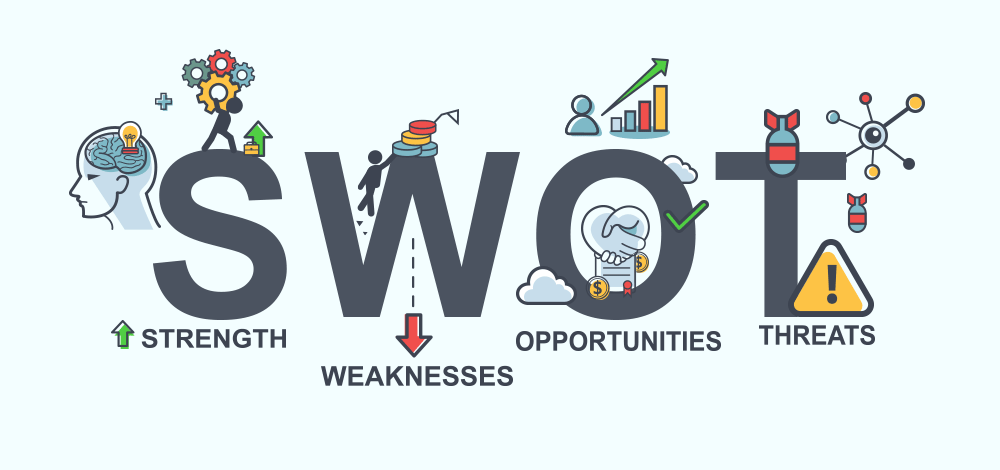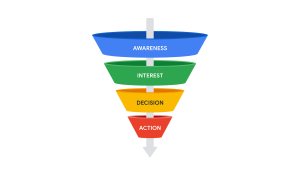In today’s competitive business landscape, organizations need to constantly evaluate their position and develop strategic plans to stay ahead. One popular framework used for this purpose is SWOT analysis, which stands for strengths, weaknesses, opportunities, and threats. It provides a comprehensive assessment of both internal and external factors that can impact a company’s performance and future potential.
In this article, we will delve into the concept of SWOT analysis, explore its components, and discuss how to conduct a SWOT analysis effectively. We will also provide a practical example to demonstrate how SWOT analysis can be applied to real-world scenarios. So let’s dive in and understand the power of SWOT analysis in strategic decision-making.

What is SWOT Analysis?
SWOT analysis is a strategic planning technique that helps organizations evaluate their competitive position and develop effective strategies. It involves identifying and analyzing internal strengths and weaknesses, as well as external opportunities and threats that can impact the organization’s performance and success.
The acronym SWOT represents the four key components of the analysis:
- Strengths: These are the internal factors that give an organization a competitive advantage over others. They can include aspects such as a strong brand, loyal customer base, unique technology, or robust financial resources.
- Weaknesses: These are the internal factors that hinder an organization’s performance or put it at a disadvantage. Examples can include a weak brand, high turnover rates, inadequate supply chain, or lack of capital.
- Opportunities: These are the external factors that can be leveraged to create a competitive advantage or enhance the organization’s performance. They can include market trends, new technologies, emerging markets, or changes in consumer preferences.
- Threats: These are the external factors that pose risks or challenges to the organization’s success. They can include factors such as intense competition, changing regulations, economic instability, or disruptive technologies.
By conducting a SWOT analysis, organizations gain valuable insights into their current situation and can make informed decisions about their future strategies. It helps them identify areas of improvement, capitalize on their strengths, mitigate weaknesses, and navigate external opportunities and threats effectively.
SWOT Table
A SWOT analysis is often presented in a table format, with four quadrants dedicated to each component of the analysis. This visual arrangement provides a quick overview of the organization’s position. Here is an example of a SWOT table:
| Strengths | Weaknesses |
| Strong brand | High turnover |
| Loyal customer base | Weak supply chain |
| Innovative products | Limited market presence |
| Robust financial resources | Outdated technology |
| Opportunities | Threats |
| Emerging markets | Intense competition |
| Technological advancements | Economic instability |
| Strategic partnerships | Changing regulations |
| Growing demand for specific products | Technological disruptions |
The SWOT table helps visualize the internal and external factors that are influencing the organization’s performance, and provides a starting point for further analysis and strategic decision-making.
How to Conduct a SWOT Analysis
Conducting a SWOT analysis involves several steps that can guide organizations towards a comprehensive evaluation of their position and the development of effective strategies. Let’s explore each step in detail:
Step 1: Determine Your Objective
Before conducting a SWOT analysis, it is important to define the objective or purpose of the analysis. This can be a broad objective or a specific question or decision that needs to be addressed. For example, the objective could be to evaluate the potential of a new product launch or to assess the organization’s overall competitive position.
Having a clear objective in mind helps focus the analysis and ensures that the outcomes are aligned with the organization’s strategic goals.
Step 2: Gather Resources
To conduct a thorough SWOT analysis, organizations need to gather relevant data and information from various sources. This can include internal data such as financial statements, customer feedback, employee surveys, and operational reports. It is also important to gather external data such as market research, industry reports, competitor analysis, and macroeconomic trends.
In addition to data, it is essential to involve a diverse group of stakeholders in the analysis. This can include individuals from different departments, levels of the organization, and external experts. This diversity of perspectives ensures a comprehensive analysis and helps uncover insights that may be overlooked by a single individual or group.
Step 3: Identify Strengths, Weaknesses, Opportunities, and Threats
With the necessary resources gathered, the next step is to identify the organization’s strengths, weaknesses, opportunities, and threats. This can be done through brainstorming sessions, interviews, surveys, and data analysis.
For strengths and weaknesses, organizations should focus on internal factors such as financial resources, brand reputation, customer relationships, operational efficiency, and employee capabilities.
For opportunities and threats, organizations should analyze external factors such as market trends, competitor activities, technological advancements, regulatory changes, and economic conditions.
It is important to encourage open and honest discussions during this step, allowing all participants to freely contribute their insights and perspectives.
Step 4: Analyze and Prioritize
Once the strengths, weaknesses, opportunities, and threats have been identified, the next step is to analyze and prioritize them. This involves evaluating the significance and impact of each factor on the organization’s performance and strategic goals.
Organizations can use various techniques such as scoring, ranking, or categorizing to prioritize the factors. It is important to consider both the magnitude of the impact and the likelihood of occurrence for each factor.
By prioritizing the factors, organizations can focus their efforts on addressing the most critical issues and opportunities that will have the greatest impact on their success.
Step 5: Develop Strategies
The final step in conducting a SWOT analysis is to develop strategies based on the insights gained from the analysis. This involves leveraging strengths, addressing weaknesses, capitalizing on opportunities, and mitigating threats.
For strengths, organizations can develop strategies to further enhance and leverage these advantages. This can include investing in research and development, strengthening customer relationships, or expanding into new markets.
For weaknesses, organizations should develop strategies to overcome or minimize these limitations. This can involve improving operational processes, addressing skill gaps through training and development, or diversifying product offerings.
For opportunities, organizations should develop strategies to seize these favorable external factors. This can include entering new markets, launching new products or services, or forming strategic partnerships.
For threats, organizations should develop strategies to mitigate the risks and challenges posed by these external factors. This can involve diversifying the supply chain, monitoring and adapting to changing regulations, or investing in technology to stay ahead of disruptors.
It is important to align the developed strategies with the organization’s overall goals and objectives, and to establish clear action plans and timelines for implementation.
Practical Example: SWOT Analysis for an Organic Smoothie Company
To better understand how SWOT analysis can be applied in a real-world scenario, let’s consider the example of an organic smoothie company. The company wants to assess its competitive position within the smoothie market and identify areas for improvement and growth. Here is a sample SWOT analysis for the company:
StrengthS
- Strong brand recognition and reputation for quality organic products
- Dedicated and knowledgeable staff providing personalized customer service
- Strong relationships with local organic suppliers, ensuring high-quality ingredients
- Well-established distribution channels and partnerships with health food stores
Weaknesses
- Limited product diversification, offering a narrow range of flavors and variations
- High turnover rates among frontline staff, impacting consistency of customer experience
- Outdated equipment and technology, hindering operational efficiency and capacity
- Limited marketing and advertising budget, resulting in low brand awareness
Opportunities
- Growing consumer demand for healthy and organic food options
- Emerging technology for online ordering and delivery, expanding reach and convenience
- Untapped market segments such as corporate wellness programs and gyms
- Increasing interest in plant-based diets and sustainability, aligning with the company’s values
Threats
- Intense competition from established smoothie chains and local juice bars
- Rising costs of organic ingredients due to supply chain challenges
- Shifting consumer preferences and trends, such as the rise of alternative beverages
- Potential disruptions in the supply chain due to natural disasters or global pandemics
Based on this SWOT analysis, the organic smoothie company can develop strategies to leverage its strengths, address weaknesses, capitalize on opportunities, and mitigate threats. For example:
- Strengthening brand awareness through targeted marketing campaigns and social media presence
- Expanding the product range to offer more flavors and variations to cater to diverse customer preferences
- Investing in staff training and retention programs to improve customer experience and consistency
- Upgrading equipment and adopting technology solutions to enhance operational efficiency and capacity
- Exploring partnerships with local gyms and wellness programs to tap into new market segments
- Diversifying ingredient sourcing to mitigate the impact of supply chain challenges and rising costs
By aligning strategies with the findings of the SWOT analysis, the organic smoothie company can position itself for growth and success in the competitive smoothie market.
Benefits of SWOT Analysis
SWOT analysis offers several benefits to organizations. Let’s explore some of the key advantages:
Comprehensive Evaluation
SWOT analysis provides a comprehensive evaluation of an organization’s internal and external factors. It helps organizations understand their strengths, weaknesses, opportunities, and threats in a structured and systematic manner. This comprehensive evaluation enables organizations to make informed decisions and develop effective strategies.
Simplified Problem Solving
Complex problems can be overwhelming to tackle. SWOT analysis simplifies the problem-solving process by breaking down the factors into four distinct categories. This simplification allows organizations to focus on specific areas and develop targeted solutions.
Consideration of External Factors
SWOT analysis ensures organizations consider both internal and external factors when making decisions. It helps organizations recognize the impact of external forces on their performance and adapt accordingly. By considering external factors, organizations can proactively respond to changes in the market and industry.
Versatility
SWOT analysis is a versatile tool that can be applied to various areas of an organization. It can be used to evaluate overall business strategy, specific product lines, marketing campaigns, operational processes, or even individual performance. Its versatility makes it a valuable tool for decision-making at different levels of the organization.
Leveraging Diverse Data Sources
SWOT analysis encourages organizations to gather data from multiple sources, both internal and external. This helps ensure a well-rounded and unbiased analysis. By leveraging diverse data sources, organizations gain a holistic view of their situation and can make more informed decisions.
Conclusion
SWOT analysis is a powerful strategic planning technique that enables organizations to evaluate their competitive position and make informed decisions. By identifying and analyzing internal strengths and weaknesses, as well as external opportunities and threats, organizations gain valuable insights that can drive their success.
In today’s competitive business landscape, organizations need to constantly evaluate their position and develop strategic plans to stay ahead. One popular framework used for this purpose is SWOT analysis, which stands for strengths, weaknesses, opportunities, and threats. It provides a comprehensive assessment of both internal and external factors that can impact a company’s performance and future potential.
In this article, we will delve into the concept of SWOT analysis, explore its components, and discuss how to conduct a SWOT analysis effectively. We will also provide a practical example to demonstrate how SWOT analysis can be applied to real-world scenarios. So let’s dive in and understand the power of SWOT analysis in strategic decision-making.




No comments! Be the first commenter?